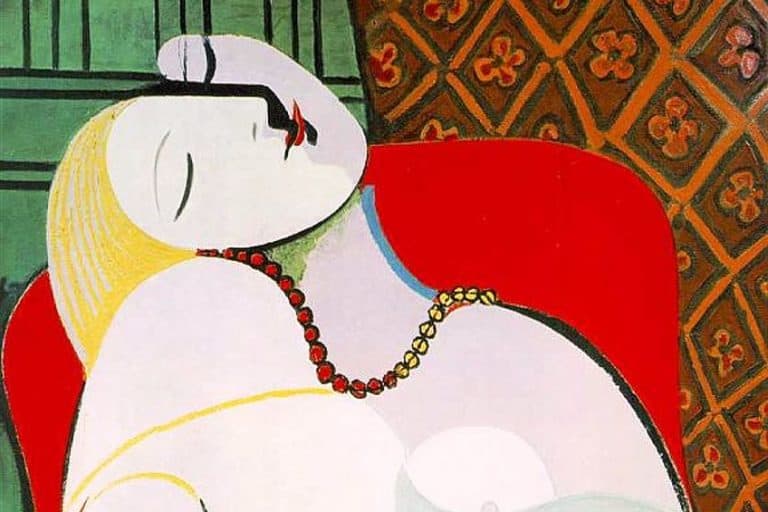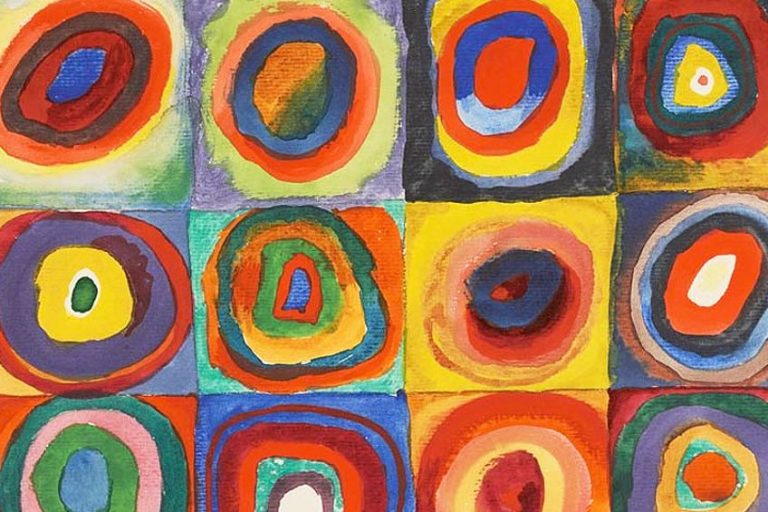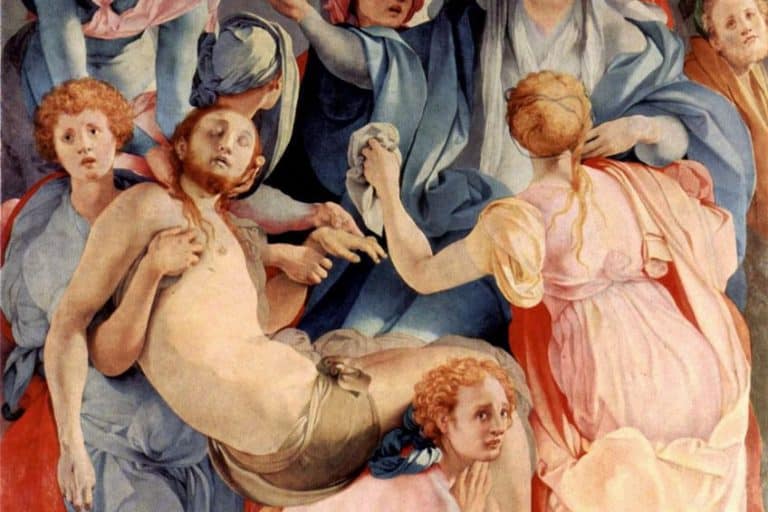Representational Art – The Development of Representational Artworks
Representational art, which is sometimes known as Figurative art, refers to paintings, sculptures, and other art forms that have clearly been copied from real objects. Portraying something that physically exists in reality, such as a landscape, a still life, or a portrait, Representational artworks are instantly recognizable once they are created. As it is one of the most identifiable genres of art, Representational art has proved popular with the masses.
A History of Representational Art
Existing as art that represents something, Representational art is typically made up of subject matters that are easily recognized by viewers. Some of the earliest examples of Representational art were cave paintings, which date back about 40,000 years ago, and the Paleolithic figurine known as The Venus of Willendorf said to be created about 25,000 years ago.
Thus, this form of art is said to be one of the oldest in existence, as a variety of examples can be traced from different genres that existed at separate times.
Most ancient art, which dates back to the Stone Age between 2,000,000 and 10,000 B.C.E., was said to be representational. The sculptures and paintings produced in this era were often modeled off of real people, idealized gods, or scenes from nature until the direction of representation turned to focus mainly on religious subjects during the Middle Ages in Europe.

Some of the most beautiful Representational art examples were created during the Renaissance by important artists such as Michelangelo and Leonardo da Vinci, who produced exceptionally realistic paintings and sculptures. At this time of art history, artists were typically commissioned to paint portraits of royalty, meaning that the majority of the artworks in existence displayed depictions of real people.
Throughout history, the majority of the paintings, drawings, and sculptures that have been made are said to be forms of Representational art, as this genre represents one of the largest collections of artworks to ever be created.
Despite going through many phases throughout art history, Representational art has retained the principle of presenting the viewer with distinct and obvious subject matter. This essentially demonstrates that it is one of the most reliable art forms to exist.
What Is Representational Art?
An appropriate Representational art definition would be artworks, in particular paintings and sculptures, that have been created by accurately copying real object sources. In doing so, the artworks that are produced represent something with strong visual references to reality, as they represent something very specific. Even when artworks were symbolic or non-figurative in nature, they were still usually representing something, which made them a form of Representational art.
Representational artworks are normally made up of landscapes, seascapes, portraits, figures, and still lifes, as these works are all comprised of images that represent an identifiable and genuine object. In addition to these categories, other forms of Representational art include depicting everyday scenes, historical and mythological paintings. In terms of Representational statues, the most common type of statue to emerge from the early art periods were equestrian statues.

While Representational art depicts objects as realistically as possible, not all Representational drawing examples are true to life.
For example, a tree can be represented through standard characteristics that we know are used to identify an object as a tree but can be placed within abstract contexts that a tree would never usually be found in. Despite the environment of paintings not always being lifelike, as long as the objects are represented recognizably, the art is automatically considered to form part of Representational art.
Traditional Representational art made use of atmospheric perspective and color in order to create the illusion of three-dimensional reality on paper or canvas. The knowledge and ability to create such realistic depictions slowly grew through the centuries as different artists arrived on the scene and helped further the Representational art definition, with this art genre never fading from popularity.
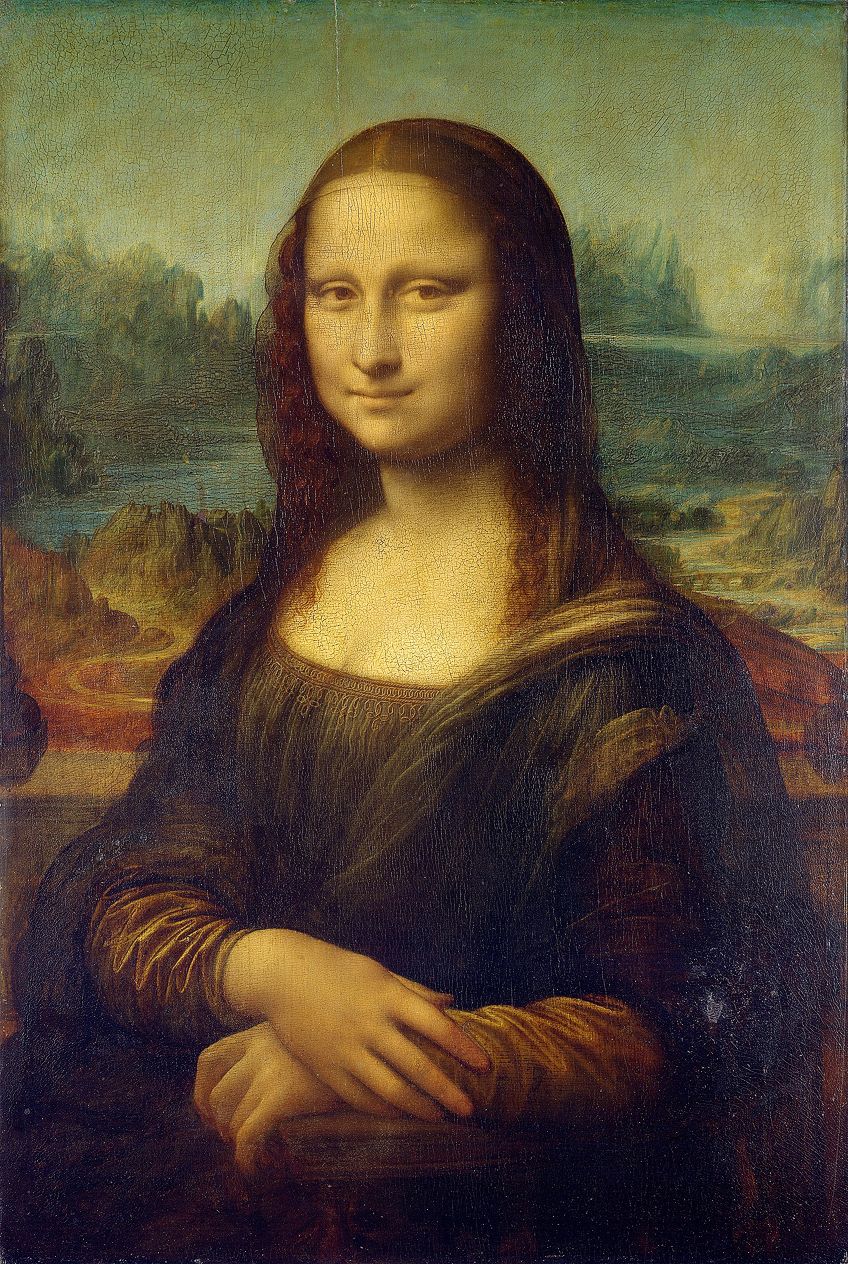
What makes Representational art so interesting is that an iconic artwork, such as da Vinci’s Mona Lisa (1503), and a simple crayon drawing of it done by an amateur would be seen as equally representational. The preference for one of these versions of the painting over the other depends on one’s aesthetic taste and not on how well the figure has been depicted.
Thus, Representational art was not a genre specifically reserved for professional artists only, as any painting or drawing that depicts a real object is considered to be a part of the style.
What Is Non-Representational Art?
By contrast, non-Representational art is incredibly different from Representational art. While most art is based on imagery and elements taken from the real world, the more extreme forms of art demonstrate an increasingly strained relationship to the visible world and are thus labeled as non-Representational art. In addition, this type of art is frequently used as a synonym to describe abstract art.
The line that separates Representational art from non-Representational art is extremely thin, as some overlapping between these two art forms still occurs. As art tends to be subjective, audiences and critics may disagree on how to classify certain artworks because of their own personal opinions.
Therefore, an appropriate non-Representational art definition describes artworks that display complete abstraction and place more emphasis on the lines, colors, and shapes seen as opposed to any objects.

With non-Representational art pieces leaning more towards abstraction, the type of artwork made makes no reference to anything remotely recognizable from the real world. The aim of these artists is to create something that is thought of as more intellectual by definition, as not making reference to any distinguishable objects requires viewers to seriously consider the work in order to form an interpretation.
Essentially, the best way to fully understand the non-Representational art definition is to consider and appreciate the differences that exist between this form of art and traditional Representational art. If you are able to see and understand themes from the viewpoint of the artist, accepting the artwork for what it then becomes a lot easier.
Non-Representational Art Examples
As non-Representational art makes use of abstraction within the artworks produced, a variety of different illustrations exist. However, the most common non-Representational art examples include artworks that do not depict any objects from the real world, such as figures and landscapes. Instead, mere shapes, colors, and lines are used to depict the ideas of the artists, as these elements are said to express elements that are not always visible, such as emotions and feelings.

20th Century Representational Art
Towards the end of the 19th century, Representational painting in Europe was dominated by the movement of Impressionism, which began around 1860. While realistic depictions of people, places, and objects were still being made, they were being painted according to the stylistic techniques of Impressionism, which was incredibly free-flowing and loose.
This led to an increase in Representational drawing, as Impressionists expressed an interest in other mediums of art in addition to painting.
This era led to the emergence of some incredibly notable artists, who created some very well-known Representational artworks. Some of these Representational artists included Edgar Degas, John Singer Sargent, Wassily Kandinsky, and even Vincent van Gogh. While all of these artists had a distinctly different style, they all produced artworks that were based on easily recognizable forms and objects, which labeled them Representational artists in addition to the art movement that they were practicing in.

At the turn of the 20th century, the different art movements that were developing began to reject the largely representational approach. A movement that abandoned the academic traditions of Representational art and embraced a more subjective approach was German Expressionism, as the political events of the early 20th century led to a massive increase in abstract art. As a result of this, non-Representational art was not said to evolve until the beginning of the 20thcentury, where form was finally given more dominance over substance.
Representational Abstract Art
In addition to the rise of the German Expressionist movement, the appeal of abstraction grew. True-to-life paintings were facing immense pressure from other artists who were unhappy with these antiquated images as they left very little room for intellectual possibilities. As a result of this, artists turned to Representational Abstract Art as a way to reinterpret and modernize subject matter.
A notable artist whose journey from Representational art into Representational Abstract Art can clearly be seen in his artworks is Pablo Picasso.
Within his Blue and Rose periods, Picasso displayed great concentration on realistic and naturalistic painting, with this interest slowly developing towards abstraction as he entered his revolutionary Cubism period. The artworks created from Picasso’s Cubism period make up some of the most famous examples of non-Representational painting ever seen.
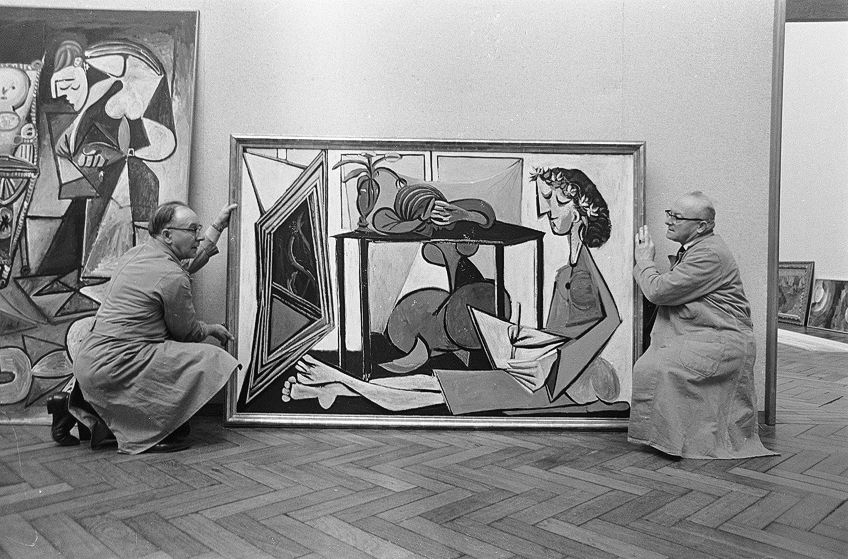
Well-Known Representational Artworks and Their Artists
As many artworks that have been produced throughout the decades portray real-life objects and figures, many of them can be seen as wonderful examples of Representational art. As too many exist to possibly be included on one list, we will be looking at four outstanding Representational artworks that each depict a specific subject matter such as human figures, a still life, animals, and a landscape scene.
Paul Cézanne: Four Apples (1881)
This oil on canvas painted by Paul Cézanne exists as an important still-life artwork, as it demonstrates his rejection of thick brushstrokes and intense contrasts of light and shadow. Cézanne did this in order to fully focus on the colors of the objects that he was painting, which helped him create incredibly naturalistic artworks.
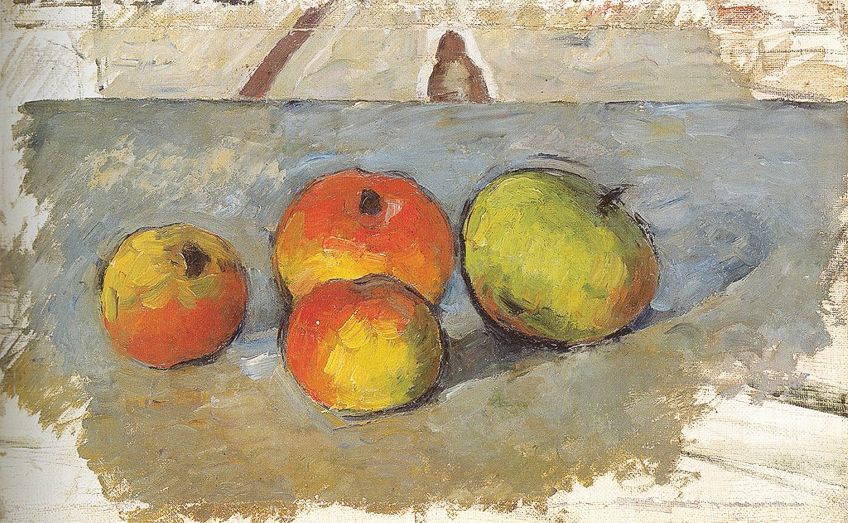
Within Four Apples, no one can mistake the four circles in the middle of the canvas to be anything other than what Cézanne said they were, which was apples. While this is certainly one of his simpler paintings, the intricacy of Four Apples lies in the depiction of its subject matter. Cézanne was able to effortlessly depict the fruit exactly as he saw it, leaving no room for viewers to confuse his work for anything else.
Joaquín Sorolla: Valencian Fishermen (1895)
Painted during the Impressionist movement, Valencian Fishermen exists as a simple work. In giving the artwork such a straightforward title, Joaquín Sorolla portrayed exactly what his artwork is labeled as, as two men standing at the water’s edge and working with fishing equipment can be seen. Thought to be an incredibly relaxed artwork, Sorolla merely depicted fishermen, assumed to be from Valencia, going about their work in the middle of the day.
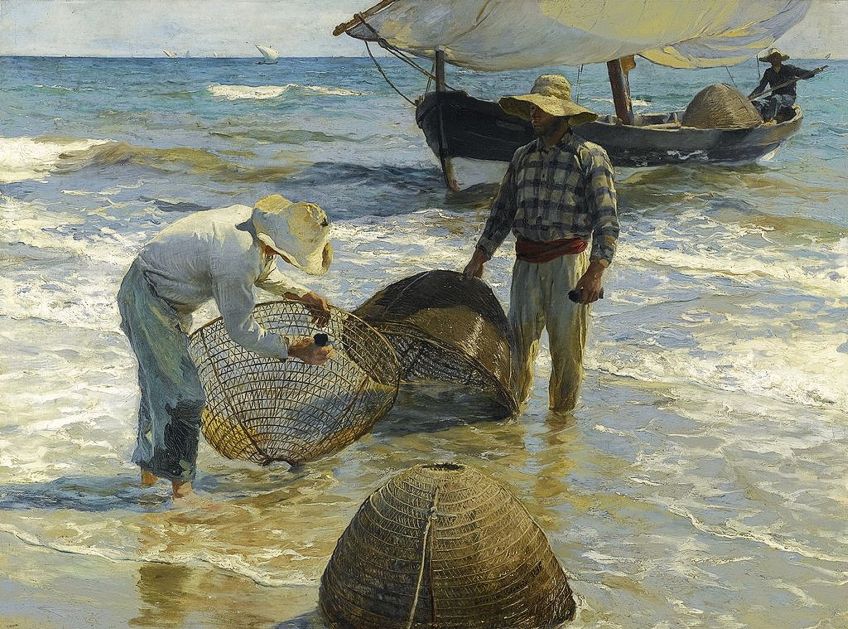
Sir Stanley Spencer: Turkeys (1925)
Created using a Neo-Romanticism style, Turkeys demonstrated the ability of artists to accurately capture depictions of animals in an incredibly realistic and thus representational style. Within this artwork, Sir Stanley Spencer clearly portrayed turkeys in the back of someone’s garden, with these animals becoming the only focal point in the painting. Based on the single word he titled the artwork, the subject matter of Spencer’s work could not be mistaken by viewers, especially after seeing the simplicity of the artwork.
Algernon Newton: The Surrey Canal, Camberwell (1935)
The final example that we have included is Algernon Newton’s The Surrey Canal, Camberwell, in which a representation of the Surrey Canal is seen. Although not explicitly a landscape artwork, as Newton included buildings that overlooked the canal, the great detail and realism with which they have been painted allow this work to be seen as a great example of Representational art. The clarity with which Newton painted The Surrey Canal, Camberwell adds to the quality of this artwork, as viewers feel as if they are looking at a photograph of the canal as opposed to a painting of it.
As Newton depicted something specific that existed in reality, he created an accurate visual reference of the canal, which allowed viewers to understand and appreciate the work immediately.
The Importance of Representational Art
Representational art made up an important period of art history, as its notable style has been represented by some of the earliest sculptures and artworks that have been documented and found. As Representational art is so widely accepted by audiences and critics alike, it still exists as a popular art form today, despite countless developments in different genres taking place.
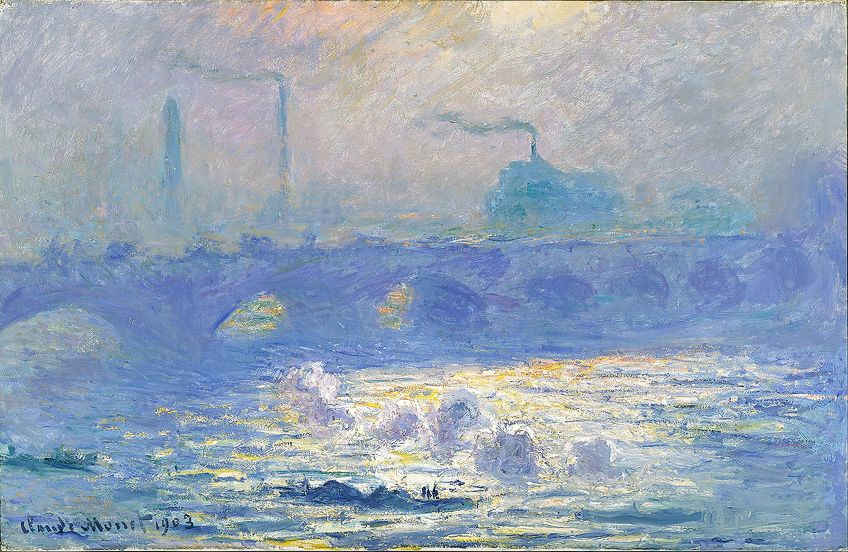
A Guideline of Artistic Merit
Representational art is considered an essential genre of art, as it provided a standard by which the artistic quality of artworks could be judged. Portraits, still life’s, and landscape paintings were judged based on their accuracy and similarity to the person and scene that was being depicted, which allowed exceptional work to be differentiated from mediocre work. However, non-Representational art differed greatly, as by not representing anything real, these abstract artworks were not able to be assessed according to objective criteria.
Due to this, the reputation of non-Representational artists varied greatly from that of Representational artists, especially at the start of the 20th century when abstraction flourished.
A Basis for All Visual Art
Representational art acted as an important starting point for all visual art, as it evaluated artists based on their drawing skills, compositional skills, perspective, use of color, and portrayal of light. While these are not the only features used to judge artists and their artworks today, these characteristics of Representational art provided a crucial foundation for the growth of visual art.
Additionally, having a solid base provided by Representational art helped introduce some of the most iconic artists in all of art history. Through creating a benchmark with which to assess artworks, this went on to educate artists from all movements to improve upon certain skills, which led to the creation of some incredibly notable works that are still spoken about today.
Makes Art More Accessible to the Public
As Representational artworks are generally very easy to recognize, the continuation of this genre helped make art more accessible to the general public as time went on. Certain artworks only received true appreciation and fame years after they were produced, which demonstrated the applicability of Representational art as these artworks were still able to be understood after a significant amount of time had passed.
With the rapid rate that technology has progressed, individuals are demonstrating a greater level of comfort with Representational art. This is because these artworks can easily be recreated using various digital tools and computer programs, which demonstrates the relevance that some Representational art pieces still have if they can be captured and altered in a completely new medium.
Despite decades passing since the first examples of Representational art emerged, this art genre has managed to remain incredibly relevant still. As all art, no matter the movement, can be seen as representational if depicting something that truly exists in reality, it becomes increasingly easy to answer the question: what is Representational art? In a nutshell, this art form simply captures elements of reality and represents them in a naturalistic way, so that viewers are able to easily recognize the subject matter artists are attempting to portray.
Isabella studied at the University of Cape Town in South Africa and graduated with a Bachelor of Arts majoring in English Literature & Language and Psychology. Throughout her undergraduate years, she took Art History as an additional subject and absolutely loved it. Building on from her art history knowledge that began in high school, art has always been a particular area of fascination for her. From learning about artworks previously unknown to her, or sharpening her existing understanding of specific works, the ability to continue learning within this interesting sphere excites her greatly.
Her focal points of interest in art history encompass profiling specific artists and art movements, as it is these areas where she is able to really dig deep into the rich narrative of the art world. Additionally, she particularly enjoys exploring the different artistic styles of the 20th century, as well as the important impact that female artists have had on the development of art history.
Learn more about Isabella Meyer and the Art in Context Team.
Cite this Article
Isabella, Meyer, “Representational Art – The Development of Representational Artworks.” Art in Context. July 5, 2021. URL: https://artincontext.org/representational-art/
Meyer, I. (2021, 5 July). Representational Art – The Development of Representational Artworks. Art in Context. https://artincontext.org/representational-art/
Meyer, Isabella. “Representational Art – The Development of Representational Artworks.” Art in Context, July 5, 2021. https://artincontext.org/representational-art/.






